Like the Sun, but 10 times hotter: Pivotal step in creation of plasma-powered reactor
An alliance of 35 countries has finished laying the groundwork for one of humanity’s most ambitious experiments – to harness nearly unlimited amounts of energy by creating ‘small stars’ on Earth.
The extreme heat and gravity inside the core of the Sun and other stars make hydrogen atoms collide and fuse into heavier helium atoms, releasing tremendous amounts of energy in the process. Scientists want to replicate a similar mechanism on Earth in order to generate energy that will be efficient, renewable and carbon emission-free, so it will not cause climate change.
Moreover, controlled fusion reactions are projected to create four million times more energy than the burning of coal, oil or gas, and four times as much as nuclear power plants. However, the design of a large-scale fusion device requires immense resources, so a decade ago 35 countries combined their efforts to build the International Thermonuclear Experimental Reactor (ITER). The reactor is being constructed outside the Cadarache research center in southern France, and the EU, the US, Russia, India, South Korea and Japan are among the participants in the ambitious project.
Also on rt.com Russia’s floating nuclear power plant ready to heat up the ArcticFusion is facilitated by high temperature, which triggers the high-energy collision of the atoms, and dense plasma, which makes such collision more likely. To control the reaction, the scientists are planning to build a tokamak, an experimental doughnut-shaped vessel-like device, capable of confining and controlling the ultra-hot plasma with powerful magnets. The idea of tokamaks was suggested by the Soviet physicists in the 1950s, and the first workable small-scale tokamaks were designed by a team led by Lev Artsimovich in the late 1960s.

The workers at the ITER paved the way for the installation of a tokamak this week when they set up an Indian-built cryostat base and its lower cylinder. Once fully completed, it will be a huge 3,085-ton stainless steel vacuum-pressure chamber needed to maintain an ultra-cool environment for tokamak’s magnets. This will help the device to generate a magnetic field powerful enough to contain plasma that will reach up to 150 million degrees Celsius, about 10 times hotter than in the Sun’s core.
And here goes the bubbly! #ITER DG Bernard Bigot and guests celebrate a major achievement: the completion of two sections of #ITER's #cryostat, the base section and the lower cylinder, a contribution to the project by India. pic.twitter.com/Tr0O5CDGJ1
— ITER (@iterorg) 23 июля 2019 г.
From there, the energy produced inside the tokamak will be absorbed as heat in its walls. The plant will then use the heat to make steam and electricity with turbines and generators, just like in a conventional power plant.
The first energy-producing ‘small star’ is set to be created inside the ITER tokamak in December 2025, but it will take at least a decade to fully power up the facility, the project’s spokesperson, Sabina Griffith, said.
Russia, meanwhile, plans to launch its tokamak T-15MD at the end of 2020. The device will be used for the ITER research. It was designed by the Kurchatov Institute in Moscow, and is based on previous working models.
Think your friends would be interested? Share this story!














